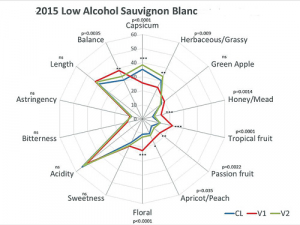Over two seasons, a School of Viticulture and Wine Science research team investigated the use of antitranspirant spray on vines to reduce photosynthesis and, as a consequence of that, the influence on berry ripeness including sugar accumulation in the berries.
The project was jointly headed by Dr Petra King and Associate Professor Carmo Saunders-Vasconcelos. The two research scientists say the significance for the New Zealand industry is that the Sauvignon Blanc fruit harvested at a lower brix level from the blocks used in the field trials produced low alcohol wine of significantly higher sensory quality than from non-treated fruit harvested from the same vineyards.
The findings, they believe, have “very exciting” implications in light of efforts underway to develop lower alcohol and less calorific wines that meet the demand of an increasingly lifestyle-attuned market.
The results from the first season’s study indicate the technique could have relevance within the seven-year, $17m Lifestyle Wines Partnership Research programme, co-funded by New Zealand Winegrowers and the Government and launched in March 2014.
The key focus of the programme is to retain the sensory attributes of a wine style that has an alcohol content of 8-10 percent. While early harvest at lower brix can produce wines with lower alcohol levels, the resulting wines are usually described as thin and lacking fruit character and being of lower quality.
EIT’s most recent research builds on earlier work undertaken by the School of Viticulture and Wine Science to investigate the use of antitranspirant spray as an alternative to defoliating -- either by hand or by machine – as a means of regulating yields.
Crop removal is a standard practice for achieving vine balance to attain optimum berry ripeness and wine quality in cool climate wine production areas.
“This is particularly so for red grape varieties where poor fruit ripening resulting in the presence of green characters in the wine can be a major quality constraint,” says the EIT research team. “Three years of data on Merlot and two with Sauvignon Blanc varieties showed that application of an antitranspirant spray to the vines just prior to flowering can reduce cluster compactness and hence the incidence of disease while reducing the yield by decreasing fruit set, berry numbers and bunch weight and enhancing fruit ripeness.”
The EIT researchers’ interest was piqued by comparable research undertaken in Italy which also evaluated the early season application of antitranspirants on grapevines. The Italian team, led by agricultural scientists Professor Alberto Palliotti, found that this approach achieved similar results.
In addition, the Italians found an antitranspirant application to the upper two-thirds of the canopy at veraison reduced the rate of sugar accumulation, resulting in a 1.2 reduction in the brix level in berries at harvest and a one percent reduction in alcohol content.
The EIT team were encouraged to trial the Italian antitranspirant approach locally. A natural organic compound extracted from the resin of pine, antitranspirant is commonly used to preserve and protect newly-transplanted plants from drying out too quickly. After application, it breaks down under ultraviolet light after three or four weeks.
A study undertaken during the 2014/15 and 2015/16 seasons centred on Sauvignon Blanc blocks some five kilometres apart in the Bridge Pa Triangle.
The results established that the antitranspirant application at veraison temporarily blocked the pores on the underside surface of the leaves so that water loss was reduced dramatically and so, the researchers say, this may affect photosynthesising by the vines.
In order to get wines of lower alcohol, the fruit was harvested early when sugars were around the 18 brix level, some 8-10 days before optimum ripeness. The Sauvignon Blanc fruit was made into a 10 percent alcohol wine in EIT’s on-campus winery.
“The results in both seasons found that while there was some evidence of a reduction in sugar accumulation by the grapes initially, there was no difference in the standard ripeness measures at the time of harvest. The exception was a reduction in the methoxypyrazine levels in antitranspirant treated fruit, which is responsible for the green capsicum characters in Sauvignon Blanc.
“The major effect of the application of an antitranspirant spray at veraison was found to be an influence on wine sensory quality.”
Eighteen trained panellists trained by Vasconcelos – undergraduate and postgraduate wine science students and faculty members with extensive wine tasting experience – assessed the wine made from grapes harvested in the first season of the study, and their sensory data covering taste and aroma appraisals was recorded in the study. (The second year of wine assessment appraisals are still to be carried out.)
The panellists found that the antitranspirant spray influenced wine quality, noting a lower level of green characters and enhanced tropical fruit and floral aromas.
The study concluded that the use of antitranspirant applied to the upper canopy of vines at veraison to influence the rate of grape ripening appeared to enhance the rate at which physiological ripeness was achieved. As such, it is a potentially useful method for producing lower alcohol wines while minimising a loss of quality.
King and Vasconcelos believe further study is needed to investigate changes in the levels of compounds responsible for wine aroma and taste, the role of seasonal influences and the effect of antitranspirant sprays on other cultivars.



